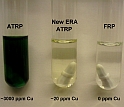|

Press Release 06-153
Vitamin C and Water Not Just Healthy for People -- Healthy for Plastics, too

New manufacturing techniques may lead to cheaper, "greener" plastics
October 23, 2006
Two new laboratory breakthroughs are poised to dramatically improve how plastics are made by assembling molecular chains more quickly and with less waste. Using such environmentally friendly substances as vitamin C or pure water, the two approaches present attractive alternatives to the common plastic manufacturing technique called free radical polymerization (FRP).
"The methods both present novel and complementary ways to dramatically improve efficiency, product control, and cost for the polymer industry," said Andy Lovinger, the National Science Foundation program director who oversees funds for the two projects. "Each of these approaches could have a very significant impact on polymer manufacturing."
Plastics are polymers, long, potentially complex, molecule chains crafted from an array of smaller chemical units. Using FRP, chemical engineers can create the right plastic for a range of applications, such as a specific trim for a car door or soft foam for a pillow.
For some plastics, the building-block molecules do not easily link together. To surmount this problem, researchers from Carnegie Mellon University in Pittsburgh, Pa., devised a process called atom transfer radical polymerization (ATRP), which provides creative ways to coax the chemical subunits into chains. However, this method comes with certain costs, such as the need for a copper catalyst that can become unwanted waste.
Now, the Carnegie Mellon researchers have discovered that adding vitamin C, glucose, or other electron-absorbing agents to the ATRP process can reduce the amount of copper catalyst by a factor of 1000. Because the catalyst often needs to be removed from the end products, less copper means far less waste and drastically reduced removal costs. Mass manufacturing could become more affordable for a range of items such as advanced sensors, drug delivery systems, paint coatings, and video displays.
The research is described in a paper in the Oct. 17, 2006, issue of the Proceedings of the National Academy of Sciences.
At the University of Pennsylvania (UPenn), researchers are using a different approach to improve FRP. Called single electron transfer-living radical polymerization, the new method relies upon relatively low-energy reactions, uses elemental copper (copper metal, as opposed to copper in a chemical solution) as a catalyst to limit byproducts and allows manufacturers to use one of the most environmentally friendly solvents in the arsenal, water. The entirely new method of polymerization builds upon existing mechanisms to craft large molecules very quickly.
The UPenn researchers presented their findings in the online Journal of the American Chemical Society on Oct. 5, 2006.
-NSF-

Media Contacts
Joshua A. Chamot, NSF (703) 292-7730 jchamot@nsf.gov
Lauren Ward, Carnegie Mellon University (412) 268-7761 wardle@andrew.cmu.edu
Greg Lester, University of Pennsylvania (215) 573-6604 glester@pobox.upenn.edu
Program Contacts
Andrew J. Lovinger, NSF (703) 292-4933 alovinge@nsf.gov
Principal Investigators
Virgil Percec, University of Pennsylvania (215) 573-5527 percec@sas.upenn.edu
Krzysztof Matyjaszewski, Carnegie Mellon University (412) 268-3209 km3b@andrew.cmu.edu
Related Websites
Carnegie Mellon press release: http://www.cmu.edu/PR/releases06/061010_pnas.html
University of Pennsylvania press release: http://www.upenn.edu/pennnews/article.php?id=1025
Matyjaszewski polymer research group: http://www.chem.cmu.edu/groups/maty/
Virgil Percec homepage: http://perceco2.chem.upenn.edu/~percec/

The National Science Foundation (NSF) is an independent federal agency that
supports fundamental research and education across all fields of science and
engineering, with an annual budget of $6.06 billion. NSF funds reach all 50
states through grants to over 1,900 universities and institutions. Each year,
NSF receives about 45,000 competitive requests for funding, and makes over
11,500 new funding awards. NSF also awards over $400 million in
professional and service contracts yearly.
 Get News Updates by Email Get News Updates by Email
Useful NSF Web Sites:
NSF Home Page: http://www.nsf.gov
NSF News: http://www.nsf.gov/news/
For the News Media: http://www.nsf.gov/news/newsroom.jsp
Science and Engineering Statistics: http://www.nsf.gov/statistics/
Awards Searches: http://www.nsf.gov/awardsearch/
| 


